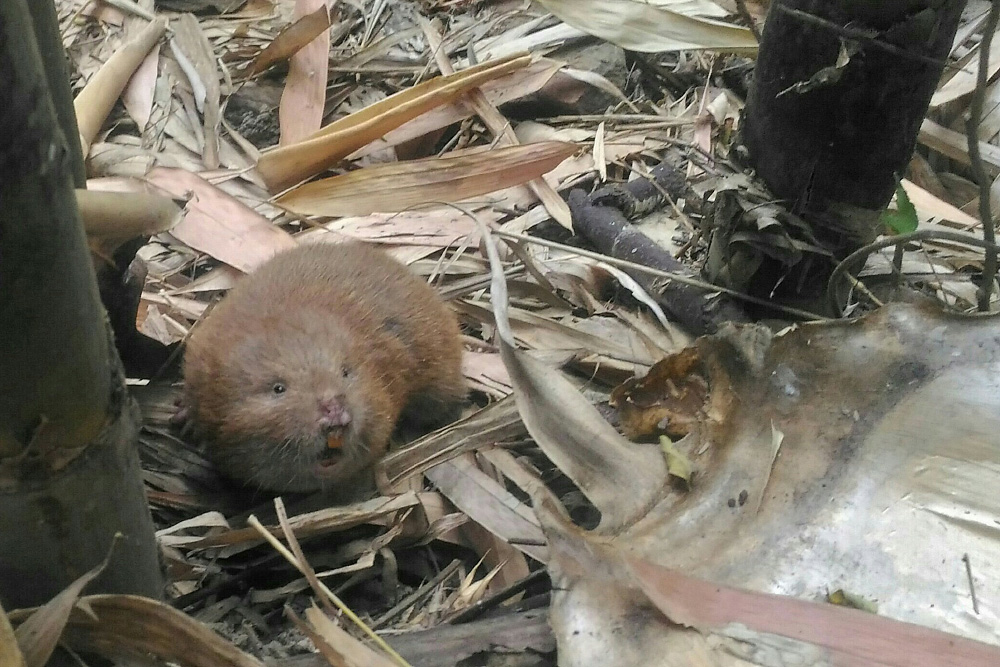 "
"
Rodents are amongst the most common mammals; and yet, they are perhaps the most ignored or overlooked. However, for an interested ‘mammals watcher’, this group comprises of some very fascinating creatures. Since my first field season in Mizoram in 2014, a sound from beneath the ground, of something vigorously digging the earth, had always drawn my attention. When asked what animal caused it, people around always had the same answer- ‘sazu’ (rodent). As I learnt more about the rodent involved, I realized it was most likely the unusual looking bamboo rat. Fascinated by its description and pictures, I was determined to see it. But sighting a rare cat would perhaps require less patience than waiting for one of these to emerge out of their underground homes.
Finally, post months of working in this landscape, on 16th Feb, 2019, around noon, as I walked ahead of rest of our team, in the western extremity of Dampa Tiger Reserve, I heard something moving through the leaf litter. The ground was covered with a dense layer of Melocanna baccifera leaves, a common species of bamboo in that area. As soon as I looked in the direction of the sound, I spotted a Lesser Bamboo Rat (Cannomys badius), also called the Bay Bamboo Rat. Around 7-8 inches long, weighing easily around 200-300 grams, it looked nothing like a rodent. The head joined rest of the body without any visible neck; the tail was highly conspicuous and around 1/3rd the length of the body; and the feet were barely visible under a cloak of thick fur. The most striking features however were the tiny, beady eyes; and large buck-teeth, orange in color.
Two species of bamboo rats are found in India – both in the Northeast – the Lesser Bamboo Rat and the larger Hoary Bamboo Rat (Rhizomys pruinosus). Both these species live in underground burrows, which comprise of tunnels spread over vast areas. In Mizoram, the Lesser Bamboo Rat is called ‘Bui’, and local people confirm that these rodents are amongst the most difficult to catch or sight. Some say, when attempts are made to pull them out of their burrows, much like ‘excavators’, they rapidly dig into the ground with their teeth and feet, making it very difficult to reach them.
As the bamboo rat walked through the leaf litter, I remained still. It continued walking in my direction, until it heard another team member approaching. At around an arm’s length from us, it stopped, and struggled to make sense of the human figures before it. It was obvious that the animal had weak vision. It remained in the same spot looking up and down for at least 2-3 minutes before it sensed us moving, and casually moved away in the other direction. I watched it for some time post that, as it slowly walked through the leaf litter down a slope, and out of sight.
Local people have many stories about these rodents. The most fascinating being one about their temperament. Easily angered, bamboo rats stand their ground if anyone comes in their way, and may attack even humans if they perceive them to be a threat! But that doesn’t stop them from being collected as an important source of food. In Manipur’s Tamenglong district, Daniel Marcus Macwan, a local conservationist, has rescued couple of these rodents from the local market – but unfortunately one came with its incisors extracted – a safety measure employed by the ruthless hunters.
IUCN categorizes bamboo rats as ‘Least Concern’ species, while the WPA, 1972, lists them in Schedule V (vermin). However, how they are impacted by vast scale jhum fires, deforestation, conversion of bamboo to monoculture plantations, or how networks of traps that we frequently encounter in these landscapes impact them remains to be determined. As of now, the IUCN categorizes Cannomys as an unresolved species complex, suggesting that even the species level distinctions for this group remain to be better understood.
During the period of this work, Priya was financially supported by an independent grant from the Rufford Foundation.

 CI is a non-profit, non-commercial portal that aims to facilitate wildlife and nature conservation by providing reliable information and the tools needed to campaign effectively.
CI is a non-profit, non-commercial portal that aims to facilitate wildlife and nature conservation by providing reliable information and the tools needed to campaign effectively.
Chosen as 'Picture of the Week'
Two species of bamboo rats are found in India - both in the Northeast - the Lesser Bamboo Rat and the larger Hoary Bamboo Rat.